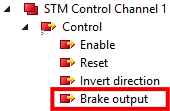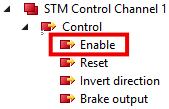Step 4: Test run
- 1. Ensure that all previous steps have been completed successfully.
- 2. Remove any load from the conveyor roller.
- 3. If the motor has a holding brake, release the holding brake: set "Brake output" to 1.

- 4. Set "Velocity" to 50% of the nominal velocity of the motor including gear unit:

Formula for calculating 50% of the nominal velocity:
|
| n: Value for the "Velocity" output variable nN: Nominal velocity of the motor in rpm i: Transmission ratio. (i = 1 if no gear unit |
- 5. Set "Enable" to 1.

- The rotor is aligned for 1 second.
- The box then attempts to turn the motor.
- 6. Assess the result.
Possible results of the test run
- If the motor rotates continuously: skip to next step of commissioning.
- If the motor does not rotate continuously:
- Set the output variable "Enable" to 0
- Check the status bits in the input variable "Device Diag".
- Evaluate the status bits with the help of the table below.
- Set the output variable "Reset" to 1. (this resets the status bits)
- Set the output variable "Reset" to 0.
- Repeat the test run: to do this, set the output variable "Enable" to 1.
Set bit in "Device Diag" | Possible reasons | Solution |
|---|---|---|
(none) | The output variable "Velocity" is smaller than the parameter 8020:09 "start velocity". | Check the calculations. |
"Channel 1 motor overload I2T error" | The output current is too high. | Reduce the value of parameter 8023:14 "Sensorless offset scaling". |
"Channel 1 commutation error" | The conveyor roller is loaded 1) | Remove any load from the conveyor roller. |
The output current is too low. | Increase the value of parameter 8023:14 "Sensorless offset scaling". | |
"Rampup velocity" is too high 1) | Check the calculation of the parameter If the calculation is correct, reduce the value of this parameter. | |
"Rampup needed switchover events" is too low. | Increase the value of parameter | |
Incorrect motor parameters | Check the motor parameters | |
The motor is too weak 1) | Insert a gear unit and recalculate all parameters. |
1) Especially likely when the motor makes a sound with ascending pitch.